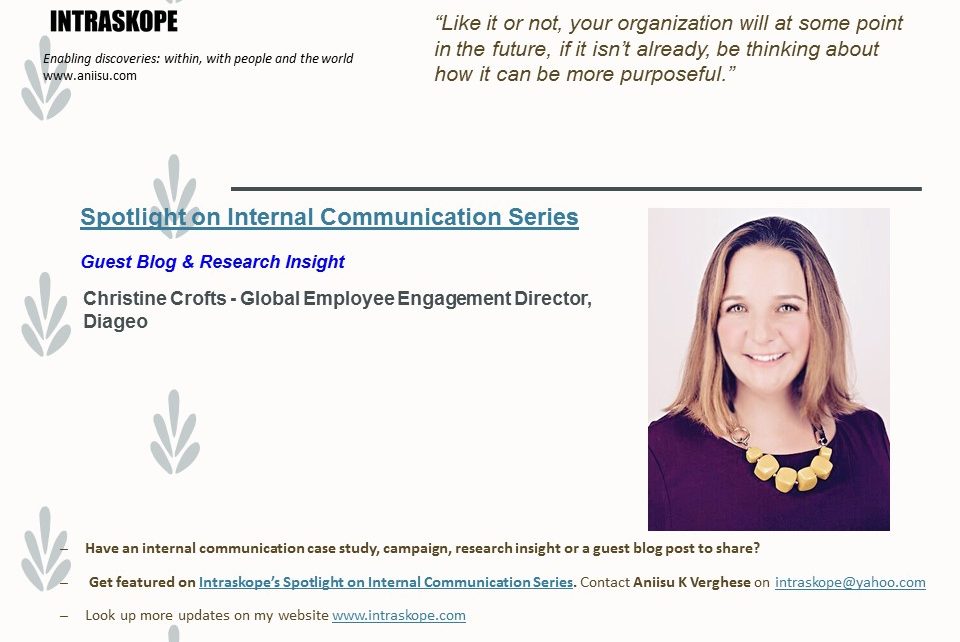Can internal communicators help amplify the organization’s purpose? What are the opportunities to bring the purpose back into the collective consciousness of the organization?
Discover answers to these questions and more in the 16th edition of Intraskope’s Spotlight on Internal Communication Series featuring Christine (Chris) Crofts of Diageo. In her guest blog, Chris shares an inspiring call-to-action on compelling missions that organizations need to embrace to make the world a better place. She follows this with research insights on humanizing employee experience.
Chris has over 17 years’ experience in corporate communications, starting out in PR and specializing in internal communications 12 years ago. She has held a number of senior in-house positions in FTSE 100 companies including HSBC and Aviva, where Chris held both market and global roles. Chris is currently the Global Employee Engagement Director at Diageo, the beverage company that owns brands such as Guinness, Johnnie Walker, Smirnoff and Baileys. Chris has a personal and professional passion for ‘Purpose’ and has published and spoken about the topic and the important role internal communications can play in creating purpose-driven organizations.
How internal communications can lead the ‘purpose uprising’
Talk about purposeful companies is everywhere. A Google search of ‘purposeful companies’ reveals more than 96 million results (that’s more than Harry Potter and Donald Trump combined!). And just last month, Larry Fink, CEO of BlackRock, one of the largest investment companies in the world, wrote to every CEO in the FTSE 100 and S&P 500 saying:
“Without a sense of purpose, no company, either public or private, can achieve its full potential….. To prosper over time, every company must not only deliver financial performance, but also show how it makes a positive contribution to society. Companies must benefit all of their stakeholders, including shareholders, employees, customers, and the communities in which they operate.”
Never before has there been so much talk of purpose amongst world leaders, business leaders and broader society. But why now? Purpose is not a new concept and certainly the marketing community have been talking about purposeful brands for decades.
What is emerging now is a multi-dimensional sense of purpose. It’s not just about what a company does for customers anymore. It’s about the difference the company makes in the world, in society, for its employees, customers and shareholders. Today’s concept of purpose is much more humanistic and broader than it’s ever been.
Academics, consultants and business schools have discussed many reasons for this. Firstly, society is changing. As more and more countries reach higher levels of development, so they move through Maslow’s hierarchy of needs, approaching the pinnacle of Maslow’s pyramid – ‘self-actualisation’ and we see a shift from ‘material want’ to ‘meaning want’. This is also a result of the ageing population, and reflects that the older you get, the more meaning you seek in life, and you become less interested in material wealth.
For the first time ever – there are now more adults over the age of 45 than under. Think of the impact that is having on our global society.
But it’s not just about the older generation’s shifting expectations. The younger generations, certainly in mature markets, mostly get whatever they want, instantly. Obtaining material things no longer gives them the same satisfaction. As they begin to join the workforce, they are demanding greater meaning from their work and lives. They want a strong sense of purpose.
“A transition from ‘material want’ to ‘meaning want’ is in progress on a historically unprecedented scale – involving hundreds of millions of people – and may be eventually recognized as the principle cultural development of our age.” Gregg Easterbrook, Editor, New Republic
Lastly, the business world is on the brink of another revolution. We’ve heard how VUCA (volatile, uncertain, complex and ambiguous) is disrupting every industry and the pressure to address the productivity gap is immense. Only the agile, innovative, customer-centric and highly productive will survive. And this is where a greater sense of purpose comes in. Organizations, and their boards in particular, are beginning to realize that a strong sense of purpose can actually build greater resilience, innovation and super charge engagement and productivity. Study after study confirms it and if you’re interested in finding our more, visit EY’s Beacon Institute.
What makes a compelling purpose these days?
I’ve briefly mentioned that the modern concept of organizational purpose is multidimensional and humanistic. But what does that really mean? It means that your purpose should:
- Aspire to make something about the world or society better
- Inspire a call to action
- Create value for employees
- Maximise shareholder value
- Bring value to customers
A compelling articulation of the above should evoke an emotional connection to your brand.
An example of such a purpose is Whole Foods, recently bought by Amazon for $13.7bn:
‘With great courage, integrity and love – we embrace our responsibility to co-create a world where each of us, our communities and our planet can flourish. All the while, celebrating the sheer love and joy of food.’
Much is written about this successful organization but if you read their annual report and accounts or visit their website, you will get a strong sense that it is indeed, driven by a strong sense of purpose. In their annual report last year, Whole Foods co-CEO John Mackey, said:
“We believe that much of our success to date is because we remain a uniquely mission-driven company.”
If purpose is so great, why isn’t everybody using it?
In a Harvard Business Review paper entitled: ‘The Business Case for Purpose’, a great question is raised. If almost all the CEOs and executives HBR interviewed said that purpose would improve employee satisfaction and success of transformation efforts, what is stopping them? The research found one key differentiator between those who had embedded purpose and those who hadn’t: poor leadership communications was preventing them from ‘activating’ purpose in their organizations.
What an opportunity this presents for our profession!
Time for Internal Communications to shine!
So you now know that most CEOs are thinking about this, and maybe you already know this because you’re already working on the Purpose of your organization. At a recent conference I asked the question ‘how many of you are currently working on refreshing or creating a new purpose for your company?’ and over 50% of the audience put their hands up. This is great news as it puts internal communicators in a great position to show their value and secure a seat at the table.
How? Here are my 5 top tips:
- Step up and own the ‘purpose opportunity’ in your organization. Initiate the conversation with your CEO. Spend time thinking about your own purpose and values and then work on your teams’.
- Help articulate the company’s purpose – make it compelling, positive and customer-focused.
- Communicate it awesomely (as you always do). And keep doing it.
- Work in partnership with HR to help leaders inspire through purpose. Help them by providing them with tools and opportunities to talk to their teams about their own purpose and values and how they connect to their organizations. And continue this by proving regular hooks for them to keep the conversation alive (this shouldn’t feel like a campaign).
- Work closely with marketing and PR to align purposeful messages externally and internally. Employees feel the organizations purpose everywhere, in their dealing with managers, in the advertising they see, and in how the media talks about company.
In summary, I’d say that Purpose is not going to go away, it is only going to be amplified. By our employees, by our customers, by society and increasingly by mainstream investors. Like it or not, your organization will at some point in the future, if it isn’t already, be thinking about how it can be more purposeful. And if it isn’t, then perhaps you should start the conversation!
Research Insight:
“Employee Experience Reimagined”
(Accenture Strategy: HR/Employee Experience study 2017)
In this research, Accenture interviewed nearly a thousand C-suite executives and their direct reports about the future of Employee Experience (EX).
Companies are investing billions to improve the Customer Experience (CX), because in this digital age where transparency is high and products and services are quickly commoditised, it is often a company’s only point of differentiation and means of building customer loyalty.
Leading companies are starting to recognise the connection between CX and EX and the most progressive companies are now creating individualised employee experiences comparable to consumer experiences: ‘If CX is the battleground for loyalty, then EX is the battleground for productivity.’
The report goes on to say that companies should consider these three insights from CX and how they could translate to EX:
- Hyper-personalization – Truly understand employees’ individual needs, preferences, attitudes, intentions and motivations, mining data sources like Glassdoor for employee insights to inform tailored experiences.
- Moments that matter – the employee equivalent of a customer’s ‘moment of truth’. This involves re-thinking the traditional standardised recruitment, onboarding, training, performance management, promotion and exit moments- and focusing much broader on how employees balance the demands of personal and professional lives every day.
- Human experiences – Even amongst digital natives, human experiences are in high demand. Winning employers will be those that put a human face on their employer brand.
The insights I take from this report relevant to our profession are mainly focused on channels. Digital technologies enable us to deliver content to colleagues that is much more personalized and relevant – but there is also a clear warning that it can’t all be about digital. We must continue to pay equal attention to face-to-face communications and how we maintain the ‘human’ experience in our channel mix.
Missed previous stories from organizations featured on the Intraskope’s Spotlight on Internal Communication Series? Look them up here – Infosys, SOBHA Ltd., ICICI Securities, First Advantage, CK Birla Group, TVS Motors, GE, Suzlon, Tata Sons, Percept, Knight Frank, TCS Europe, Vedanta, Oxfam and Danske Bank.
Intraskope (www.aniisu.com) is the first blog on internal communications in India and among the earliest around the globe. Begun in 2006, the blog has over 530 posts on topics such as employee engagement, leadership communication and employee branding and receives thousands of visits from across the world. The blog, receives over 50,000 visits every month from over 50 countries globally, offers learning resources for practitioners, academicians, and students including industry workshops, research reports, and checklists. Intraskope has been featured on leading global internal communication forums like Simply-Communicate, IC Kollectif and International Association of Business Communicators. It is hosted by Aniisu K Verghese, author of Internal Communications – Insights, Practices & Models (Sage, 2012).
If you are an internal communication leader working in a firm or a not-for-profit anywhere in the world and have an internal communication case study, campaign, research insight or a guest blog post to share please contact me on intraskope@yahoo.com
You can also visit my website www.intraskope.com and You Tube channel to know more about my work

